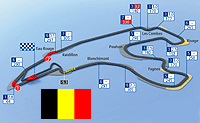- Home
-
News
-
Latest News
- Schumacher's iconic first race winner is for sale
- Cadillac partners with AI technology company
- Hamilton comes out fighting
- "I had the worst job in F1," says Perez
- Lambiase set to remain at Red Bull
- A change of plan for Haas
- FIA tweaks qualifying
- Mercedes and Williams confirm reveal dates
- Red Bull's head of strategy joins McLaren
- More News
-
-
Drivers
-
Current Drivers
- Lando Norris
- Max Verstappen
- Gabriel Bortoleto
- Isack Hadjar
- Pierre Gasly
- Sergio Perez
- Andrea Kimi Antonelli
- Fernando Alonso
- Charles Leclerc
- Lance Stroll
- Alexander Albon
- Nico Hulkenberg
- Liam Lawson
- Esteban Ocon
- Arvid Lindblad
- Franco Colapinto
- Lewis Hamilton
- Carlos Sainz
- George Russell
- Valtteri Bottas
- Oscar Piastri
- Oliver Bearman
- Test/Reserve Drivers
-
-
Teams
-
Current Teams
- McLaren Formula 1 Team
- Mercedes-AMG Petronas Formula One Team
- Oracle Red Bull Racing
- Scuderia Ferrari HP
- Atlassian Williams F1 Team
- Visa Cash App Racing Bulls Formula One Team
- Aston Martin Aramco Formula F1 Team
- TGR Haas F1 Team
- Audi Revolut F1 Team
- BWT Alpine F1 Team
- Cadillac Formula 1 Team
-
-
Tracks
-
Current Circuits
- Melbourne (Australia)
- Shanghai (China)
- Suzuka (Japan)
- Sakhir (Bahrain)
- Jeddah (Saudi Arabia)
- Miami (USA)
- Montreal (Canada)
- Monaco (Monaco)
- Barcelona (Spain)
- Red Bull Ring (Austria)
- Silverstone (UK)
- Spa-Francorchamps (Belgium)
- Budapest (Hungary)
- Zandvoort (Netherlands)
- Monza (Italy)
- Madring (Spain)
- Baku (Azerbaijan)
- Singapore (Singapore)
- Austin (USA)
- Mexico City (Mexico)
- Interlagos (Brazil)
- Las Vegas (USA)
- Losail (Qatar)
- Abu Dhabi (UAE)
-
- Seasons
-
Pictures
-
Latest Galleries
- 2025 Abu Dhabi Post-Season Test 9 Dec
- 2025 Abu Dhabi GP
- 2025 Abu Dhabi Saturday
- 2025 Abu Dhabi Practice
- 2025 Qatar GP
- 2025 Qatar Saturday
- 2025 Qatar Practice
- 2025 Las Vegas GP
- 2025 Las Vegas Saturday
- 2025 Las Vegas Practice
-
Gallery Categories
- 2026 Season
- F1 Testing
- 2025 Season
- All galleries
-
- Stats
- JOHNNYBET

 Seventy-two years ago, it no doubt seemed like an innocuous change to speed up the circuit layout. When the teams arrived for the 1939 Belgian Grand Prix at the end of the June, the fiddly Virage de l'Ancienne Douane (Customs House Hairpin) early in the lap had been bypassed with a new, steep uphill section linking to the long straight towards Les Combes. The new section probably merited little special consideration in comparison with the rest of the 14-kilometre circuit, which included sections like Burnenville, the Masta Kink and the run from Stavelot to La Source. The old Spa disappeared from the calendar in 1970, to return in 1983 using a layout that was half the length and had been made significantly safer in order to meet the needs of modern motor racing.
Seventy-two years ago, it no doubt seemed like an innocuous change to speed up the circuit layout. When the teams arrived for the 1939 Belgian Grand Prix at the end of the June, the fiddly Virage de l'Ancienne Douane (Customs House Hairpin) early in the lap had been bypassed with a new, steep uphill section linking to the long straight towards Les Combes. The new section probably merited little special consideration in comparison with the rest of the 14-kilometre circuit, which included sections like Burnenville, the Masta Kink and the run from Stavelot to La Source. The old Spa disappeared from the calendar in 1970, to return in 1983 using a layout that was half the length and had been made significantly safer in order to meet the needs of modern motor racing.



















sign in